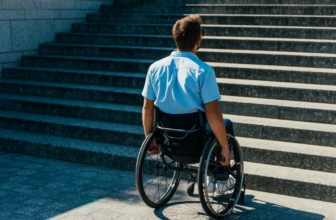Non-verbal communication and behavior are two of the most problematic aspects of teaching and counseling people who were born with total or partial blindness.
Two views have historically developed regarding the non-verbal behavior of those with visual impairments. The first one is that non-verbal behavior is innate and training and rehabilitation can do little to improve it. Of course, such views belong to the past. In recent decades, a second view has taken hold, promoting the idea that the non-verbal behavior of congenitally blind people is developmental and can be greatly improved as a result of continued hard work.
In this article, I will summarize and explain some of the most important factors and aspects of the non-verbal behavior of people with congenital blindness and will discuss some exercises and tips on how to support them in developing non-verbal skills.
You will learn:
Which factors impact non-verbal communication development in children who are born blind?
Sensory deficiency
What it is:
Of course, the most obvious factor is the lack of visual sensory input. On one hand, people who are congenitally blind cannot perceive the non-verbal language of sighted people and cannot read the non-verbal messages. Severely impaired or completely missing vision leads to a deficiency of sensory information that does not allow them to perceive and understand the literal and figurative social meaning of facial expressions and gestures, gaze, facial expression, or body language. On the other hand, people who are born blind are unable to send an adequate non-verbal message to others, due to the limited set of non-verbal means of expression that is accessible to them. Numerous studies, such as this one demonstrate that “children with visual impairments are at risk for sensory processing difficulties.”
How to help:
Parents or caregivers should use any opportunity to teach and stimulate the use of other sensory modalities for processing information and exploring the surrounding world. This shouldn’t be forced onto the child and shouldn’t feel like something mandatory or lesson-like. We should use simple daily activities such as:
- A walk in the park: to explore by touch and smell various trees, leaves, and flowers; to talk about the weather, feeling the sun or wind on our skin; to interact with other people and discuss what they do in the park, and many other activities.
- Preparing dinner in the kitchen: to sort the spices and learn to recognize them by smell; to learn the difference between raw and cooked foods, and recognize when food has gone bad; to discuss why people enjoy some foods and what is their cultural or social meaning, etc.
- Going to the store: to discuss what we need and where to find it, what people do there, how to ask for help, and so on.
Many families exclude their children with a visual impairment from any daily tasks, outdoor activities, or social gatherings, trying to protect them from possible harm and injury. While some safety precautions are of course reasonable and necessary, this approach generally deprives the child of the chance to develop skills for social interaction, independence, and compensatory sensory skills.
Limited opportunities for imitation
What it is:
We learn most non-verbal behaviors by observing, visually modeling, mirroring, and imitating others – opportunities that are not accessible to children with congenital blindness.
How to help:
Studies, such as this one, demonstrate that “lacking access to visually-oriented means of communication (eye contact, shared gaze), blind children are especially dependent on the vocal channel for social interaction.” Precise and detailed verbal descriptions, combined with tactile and/or auditory input as often as possible, are the main source of information and learning. We may use activities such as:
- Etiquette training and exercises in both natural and simulated situations — for example, playing a game of hosting a tea party or riding on the bus.
- Watching and discussing audio-described movies and videos together.
- Listening to audiobooks, imitating the characters and stories, etc.
What are some specific aspects of non-verbal behavior that should be taught to children with congenital blindness?
Gestures and mimics
What they are:
Expressive, descriptive, and demonstrative gestures are usually limited or missing in people with congenital blindness because they have little or no visual experience. In people with low vision, such gestures may be different from those of sighted people due to the incomplete visual information and capacity for imitation and learning. Instinctive and nervous gestures, though usually limited, occur in people with congenital blindness.
How to help:
We can try activities such as:
- Drama and acting lessons focused on body language, expressions, and gestures in various simulated situations
- Reading: expressive, echo, and chorus reading
- Retelling stories with an emphasis on gestures and expressions
- Reciting poetry
- Singing and public speaking
Eye contact
What it is:
Eye contact is one of the most difficult behaviors to learn for many people with total blindness because it feels unnatural and unnecessary to them. Some people who have total blindness may prefer to turn their ears toward the person who is talking, instead of their eyes. People who have low vision may try to stand too close or stare intensely while trying to obtain visual information in the best way possible. All this, even though completely logical and understandable, may be interpreted by others as strange or socially unacceptable.
How to help:
Gradually teaching self-control and body awareness, together with auditory training are the main ways to develop conversational skills such as eye contact and body direction. “Follow my voice” exercises in real and simulated conversations and activities involving focus and attention may be useful.
Posture
What it is:
This is one of many studies that found that “a blind child develops abnormal postural reflexes and faulty motor patterns, leading to incorrect distribution of muscular force throughout the body which precipitates postural and balance deficits.” Posture difficulties worsen if the child doesn’t get enough physical exercise and activities or if he/she is not being trained to move and walk independently.
How to help:
- Teaching body awareness and independent movement skills is crucial and should start as early as possible.
- PE and sports are very important for children with visual impairments and it’s a mistake to leave them waiting on the bench or just give them the scorekeeper role in PE classes. There are many ways to practice sports and be physically active as a person with a visual impairment.
- Dancing is a great way to exercise, practice mobility, body control, coordination, and sensory integration skills, as well as learn to enjoy movement, make friends, and gain self-confidence.
- Drum circle therapy can be an accessible way of self-expression and building a connection within a group. It also relieves tension and stimulates coordination between hearing and movement.
How do we help blind children who struggle with stereotyped movements/mannerisms?
What are stereotyped movements/mannerisms?
When observing children with visual impairments, we often notice that some of them demonstrate monotonously repeating stereotyped movements such as shaking the body or the head, pressing the eyeballs with fingers, turning the head, shaking a small object in front of the eyes, clapping hands, etc. In the past, these behaviors were defined as “blindisms” — a term that is incorrect and no longer used, because such movements are not exclusively typical for people with blindness. The terms most used today are mannerism, manneristic behavior, or stereotyped movements. There is, however, no unified definition of stereotyped movements. The American Psychological Association defines them as “movements that are both aimless and repetitive.” Such monotonous, repetitive, involuntary, and aimless movements are often observed in sighted people too, but they usually don’t affect social and personal communication and interaction.
What causes stereotyped movements?
There are numerous theories and studies on mannerism and its causes. Most of them, such as this one, find that the main causes are rooted in trying to “cope with tensions created by situations of frustration, fear, excitement, stimulation deficit, physical activity deprivation, insecurity, etc.” and lacking “strong instrumental coping skills.” Four typical situations are often identified as provoking stereotypic behaviors: monotony, arousal, demand, and during feeding or eating.
Based on these and other studies and theories, I can summarize that some of the most common causes of stereotyped movements are:
- Environmental deprivation. A child with total blindness for example, especially if neglected, left alone in their room for a long time, tries to compensate for the lack of stimulation from the environment.
- Substitute for physical activity
- Reaction to stress and frustration
- Lack of visual feedback
- Learning through repetition
- Developmental problems
- Poor sensory and/or motor skills
How can stereotyped movements be reduced?
The first thing to remember is, that each child who demonstrates stereotyped behaviors should get an individual assessment and therapeutic program. There is no formula or a set of solutions that fit all. This should only be done by qualified professionals, such as psychologists, vision rehabilitation specialists, and specialists in education for people with visual impairments, preferably working together in a team. Depending on the frequency, intensity, provoking situations, type of the behaviors, and other factors, such as age, development, and personal traits of the child, the recommended activities for reducing mannerisms, may include, but not be limited to:
- Modifying the environment where the movements occur or distracting the child with another activity when they demonstrate the stereotyped movements
- Replacing the undesired movements with a useful habit
- Rewarding the child when the undesired behavior is not demonstrated
- Practicing relaxation or meditation techniques
- Introducing more physical activity
- Verbal instructions with a “code” word: the parent/teacher/caregiver pronounces a word or phrase, negotiated between them and the child when the behavior is demonstrated, and the child knows they have to stop. This is useful when they are in public or with other people because it eliminates the necessity of the caregiver to correct the child, this way causing embarrassment
- The same can be done with a discrete touch or movement, negotiated in advance, such as a gentle tap on the shoulder.
DON’Ts:
- Isolate or punish the child. This will most certainly worsen the situation. “Restricted environmental conditions, reduced sensory stimulation, and reduced motility” were found to increase the undesired behaviors.
- Use an aggressive, insulting, or judgemental tone when speaking about stereotyped behaviors to the child, in their presence, or when trying to correct them. These movements are involuntary, remember? They are not the child’s choice or fault. Besides, more stress and frustration would lead to more undesired movements.
- Ignore these behaviors. Sometimes, they decrease on their own with age, but other times they increase and can worsen the child’s ability to focus at school, not to mention, that they are usually considered socially unacceptable and impede communication.
- Give up if one method doesn’t work. There is no unified and strict definition of stereotyped behavior, the causes are still an object of research, and therefore, there are no guaranteed and generally or officially approved methods of impact on them.
- Fall prey to charlatans who promise quick fixes, and offer you pseudo-scientific “treatments”.
- Give up on rehabilitation services, such as Daily Living Skills or Orientation & Mobility training; or deprive the child of social interactions or other activities just to hide from others that they have stereotyped movements. The more boredom, sensory deprivation, and lack of physical activity, the more likely the undesired movements persist and worsen.
- Be a perfectionist. Often stereotyped behaviors are very hard or even impossible to eliminate completely. If they can be reduced enough to not impede focus, daily functionality, and social interaction; or if the child manages to learn only to do them in private, when alone at home, this is a great success.
DOs:
- Look for professional help from qualified specialists.
- Get informed by proven, trustworthy, and respected sources.
- Get involved in support groups and communities focused on people with visual disabilities, to learn and exchange experiences.
- Be very patient. Mannerisms are very hard to reduce and this process requires a long time. You will probably not see results quickly.
- Involve the child (and the whole family) in Early Intervention (EI) Vision Specialty Services as early as possible!
What else can we do to help blind children with non-verbal communication?
In this article, I talked about helping and teaching people with visual impairments how to participate in non-verbal communication. Learning and improving all these skills I mentioned is important and it’s more than great when people with visual (and all other) disabilities are encouraged to be active, independent, and self-confident.
However, we must never forget that as a society, we all have a responsibility to make our environment, including the means of communication, more inclusive and accessible to everyone. Apart from advocating for accessibility of urban environment, transport, and technologies, each sighted person can familiarize themselves with Blind Etiquette and try to make communication easy and pleasant for all participants.
Books and Resources for Teaching Blind Children
My name is Iva and I am a beginner freelance writer and translator.
I have a Master’s degree in counseling psychology and a Master’s degree in Education for people with visual disabilities.
For over 10 years I have been working as a psychologist and educator, mostly, but not only, in the field of education and social inclusion of people with visual disabilities.
I am an Orientation and Mobility teacher and a Basic Rehabilitation instructor.
I hope writing can help me reach out to more people and share my experience and knowledge with them.












